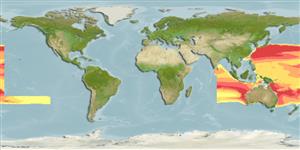>
Acropomatiformes (Oceanic basses) >
Malakichthyidae (Temperate ocean-basses)
Etymology: Malakichthys: Greek, malakia = softness + Greek, ichthys = fish (Ref. 45335); barbatus: Specific name meaning 'bearded', referring to the numerous spines on the chin..
Environment: milieu / climate zone / depth range / distribution range
Ökologie
seewasser bathypelagisch; tiefenbereich 100 - 600 m (Ref. 40964). Temperate
Indo-west Pacific: Japan, South China Sea and Australia.
Size / Gewicht / Alter
Maturity: Lm ? range ? - ? cm
Max length : 18.0 cm SL Männchen/unbestimmt; (Ref. 40964)
Kurzbeschreibung
Morphologie | Morphometrie
Rückenflossenstacheln (insgesamt): 10; Rückenflossenweichstrahlen (insgesamt): 10; Afterflossenstacheln 3; Afterflossenweichstrahlen: 7 - 8. Numerous pairs of spines on chin: 13 paris on chin, 7 pairs on outer ridges, 4 pairs of inner ridges and 2 pairs on the middle. Opercle with a dark blotch between the small upper and large lower spines. First proximal radial of anal fin slender, not hollow; anal fin rays III, 7 (rarely 8). Body depth 30-35% SL. Gill rakers on lower arm 20-22 (rarely 23). Ctenoid scales deciduous. Mouth oblique (Ref. 40964).
Life cycle and mating behavior
Geschlechtsreife | Fortpflanzung | Ablaichen | Eier | Fecundity | Larven
Yamanoue, Y. and K. Yoseda, 2001. A new species of the genus Malakcihthys (Perciformes: Acropomatidae) from Japan. Ichthyol. Res. 48(3):257-261. (Ref. 40964)
IUCN Rote Liste Status (Ref. 130435)
Bedrohung für Menschen
Harmless
Nutzung durch Menschen
Mehr Information
NamenSynonymeMetabolismusRäuberÖkotoxikologieFortpflanzungGeschlechtsreifeAblaichenSpawning aggregationFecundityEierEientwicklung
Alter/GrößeWachstumLänge-GewichtLänge-LängeLängenhäufigkeitenMorphometrieMorphologieLarvenLarven Pop.Dyn.RekrutierungDichteBRUVS
ReferenzenAquakulturAquakultur ProfilZuchtlinienGenetikElectrophoresesVererbbarkeitKrankheitenVerarbeitungNutrientsMass conversion
PartnerBilderStamps, Coins Misc.LauteCiguateraGeschwindigkeitSchwimmstilKiemenoberflächeOtolithsGehirngrößeSehfähigkeit
Tools
Zusatzinformationen
Download XML
Internet Quellen
Estimates based on models
Preferred temperature (Ref.
123201): 11.7 - 21.3, mean 17 °C (based on 97 cells).
Phylogenetic diversity index (Ref.
82804): PD
50 = 0.5078 [Uniqueness, from 0.5 = low to 2.0 = high].
Bayesian length-weight: a=0.00479 (0.00182 - 0.01257), b=3.12 (2.89 - 3.35), in cm total length, based on LWR estimates for this (Sub)family-body shape (Ref.
93245).
Trophic level (Ref.
69278): 3.7 ±0.5 se; based on size and trophs of closest relatives
Fishing Vulnerability (Ref.
59153): Low vulnerability (12 of 100).
